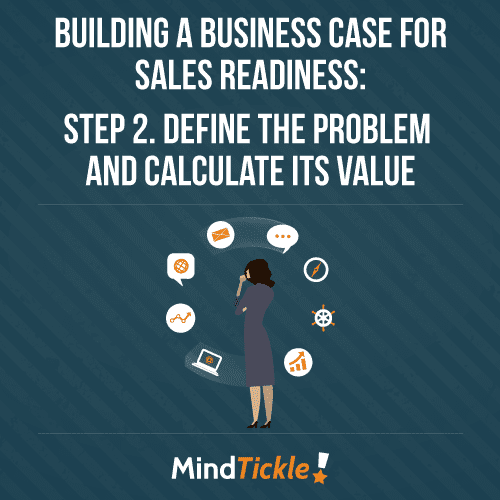Building a Business Case for Sales Readiness – Step 2: Define the Problem and Calculate its Value
 In my last post, we discussed how to go about identifying the issue or symptom that your business is experiencing. The next step in building a business case for sales readiness is to define the exact problems your business is experiencing.
In my last post, we discussed how to go about identifying the issue or symptom that your business is experiencing. The next step in building a business case for sales readiness is to define the exact problems your business is experiencing.
The only way to start honing in on the problem is to identify the metrics that you need to measure for each issue. This will also help you measure your baseline, and in the future, demonstrate the benefit of your readiness initiatives.
Some examples of translating issues into specific metrics include:
With your broad metrics identified you can then design your end goals. For example, if your metric is to improve onboarding ramp-up time, your goal may be to improve how long it takes for your new hires to reach quota. To determine the metrics your business needs to focus on partnering with Sales Ops. This will ensure that you’re both in agreement on what your goals are and work towards reaching the same desired state.
It’s also important to ensure your programs are tightly aligned with the objectives of your sales leadership. While it’s easy to focus in on training, this may only solve part of your problem. Sales reps need to be enabled with a range of things – knowledge, skills, coaching, reinforcement, content, and process – not just training. That’s why it’s important to have access to as many analytics and data points as you can. Research has found that organizations that use sales analytics increase team quota attainment 4x faster than non-users. Sales Ops is often the starting point here, as they use sales analytics to improve forecasting, find ways to ensure that revenue becomes more predictable and identify opportunities to improve sales effectiveness.
Identify all the stakeholders
Sales Ops, as the expert in data and impact correlation, is an important stakeholder for Sales Enablement but they’re not the only one. 36% of businesses don’t make a concerted effort to foster collaboration between sales enablement and other parts of the company.
For your sales readiness initiatives to succeed, Sales Enablement must be the hub that connects the sales team to the different departments that can influence their performance or will be affected by it. For example, if an initiative will save money then involve Finance – they may even be your champion or decision maker further down the track.
Other key players include Marketing who understands messaging and Product who is crucial for any product training and updates on features. And of course, the leadership team who are enablers when it comes to achieving alignment across the company. If you can demonstrate the success of your initiatives you will be well-positioned to ask the leadership team to help you – whether it’s involving other teams or driving adoption amongst your sales organization.
While reps are usually the focus of enablement initiatives, frontline managers also need to be enabled. Win rates can increase by 9% and revenue attainment can increase by up to 18% if you invest in your frontline sales managers. For example, providing them with structured coaching frameworks can increase quota attainment by 10%.
Calculate the real value of your initiatives
Once you’ve identified your stakeholders and key problems, prioritize them so you can identify which to focus on first. Best-in-class businesses select just a few initiatives to implement successfully before moving onto the next.
The best way to prioritize your initiatives is by the value each will add to the business.
This isn’t easy to do, especially when you don’t have access to perfect data, but it’s an essential part of the process. Benchmark your business against external research, ask stakeholders what benefit they expect to see and speak to Sales Ops to deter
mine the best way to measure your initiative
For example, to measure the effectiveness of your reps demos start with their current conversion rate – perhaps demo to opportunity is 20%. If certifying your reps increases the conversion rate to 25%, then extrapolate from there. If each demo potentially earns $20,000 and each rep does 50 demos a month then: $20,000 * 50 * 5% = $50,000
That’s $50,000 more revenue each rep can earn a month or $600,000 a year. That’s $6 million a year if you have 100 reps. Now, that’s a compelling argument. This table shows some metrics alongside external data points that may help you calculate the value of your initiatives.
While not all of these metrics will be appropriate for your sales readiness initiatives, they provide you with a starting point to define your problem and back it up.


